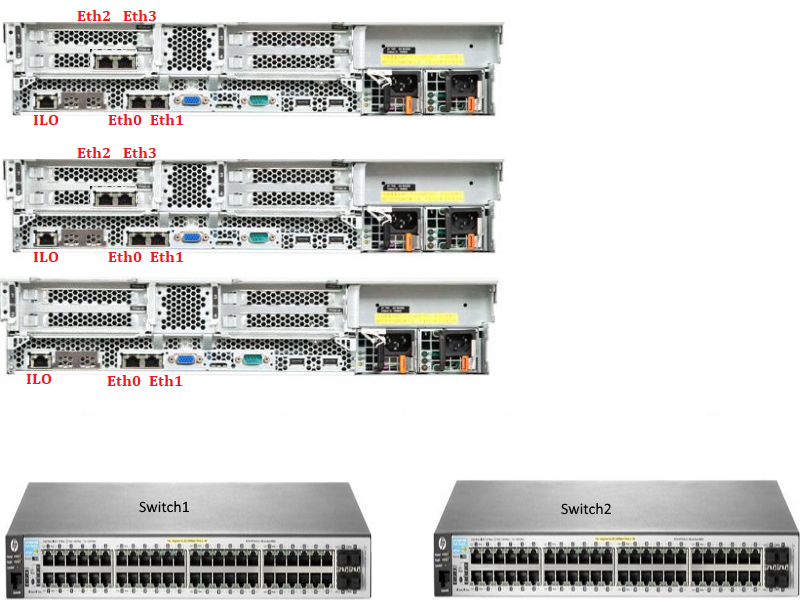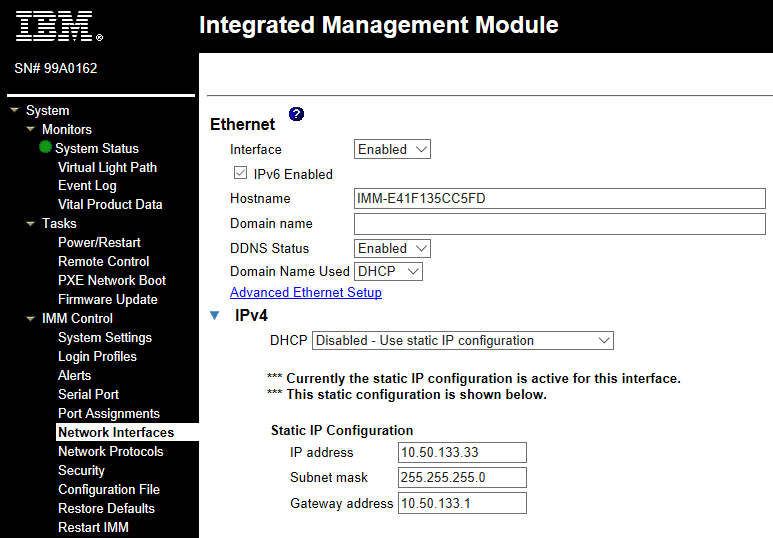In this part, we will plan the IP configuration, VLANs and network switch ports connections. Of course these details will be different in your environment but this plan is important and these details might be beneficial for others when they prepare their own environment.
I will be using 2 VLANs. VLAN 2132 will be used for virtual machine network and ESX management network. VLAN 2133 will be used for Vmotion and Server and Storage Management connections. It is very important to keep VM Network and Vmotion network seperate. If you keep VM Network and Vmotion network in the same VLAN, VM migration speed will suffer immensely. There is a good article that explains in detail about this subject in the following link:
SERVERS:
Here you can see how I am going to use my servers ethernet ports. 1 Vm Network and 1 Vmotion network for each network card. I have to make sure If one NIC fails, the service can keep working on the other NIC.
This System X 3650 M3 server. Unfortunately, X3650 M2 server has only 1 NIC. So It will have 1 ILO (IBM calls this as IMM) port, 1 Vm Network and 1 Vmotion connection.

Now Lets plan how we connect the network cables from servers to network switches in detail including IP addresses and VLANs.

Note that Vm Network Ports should be set as Trunk on Network switches. Because we want these ports to reach other VLANs on the network.
Also, note that Switch1 and Switch2 section especially, if one of the switch fails the vmnetwork and vmotion services can keep on working.
IBMESX01
| Ports | IP Address | VLAN | Switch1 Port | Switch2 Port | |
| IBMESX01 | 10.50.132.201 | 2132 | |||
| Server1 ILO | ILO | 10.50.133.33 | 2133 | 10 | |
| Server1 VmNetwork + (ESX Mng) | Eth0 | 11(Trunk) | |||
| Server1 Vmotion | Eth1 | 10.50.133.41 | 2133 | 12 | |
| Server1 VmNetwork + (ESX Mng) | Eth2 | 13(Trunk) | |||
| Server1 Vmotion | Eth3 | 10.50.133.41 | 2133 | 14 |
IBMESX02
| Ports | IP Address | VLAN | Switch1 Port | Switch2 Port | |
| IBMESX02 | 10.50.132.202 | 2132 | |||
| Server2 ILO | ILO | 10.50.133.34 | 2133 | 10 | |
| Server2 VmNetwork + (ESX Mng) | Eth0 | 11(Trunk) | |||
| Server2 Vmotion | Eth1 | 10.50.133.42 | 2133 | 12 | |
| Server2 VmNetwork + (ESX Mng) | Eth2 | 13(Trunk) | |||
| Server2 Vmotion | Eth3 | 10.50.133.42 | 2133 | 14 |
IBMESX03
You can see that I don't have redundant connection for this server. Lack of number of ports on my server prevents me. If 1 of this connection fails, service fails for this ESX host :(
| Ports | IP Address | VLAN | Switch1 Port | Switch2 Port | |
| IBMESX03 | 10.50.132.203 | 2132 | |||
| Server3 ILO | ILO | 10.50.133.35 | 2133 | 21 | |
| Server3 VmNetwork + (ESX Mng) | Eth0 | Trunk 22 | |||
| Server3 Vmotion | Eth1 | 10.50.133.43 | 2133 | 23 |
SAN SWITCH: I am not going to connect my SAN Switches to network switches but if I was I would keep them in VLAN 2133 and assign an ip address from there. I will manage my SAN switch thru Serial Port.
DS5100 STORAGE CONTROLLER:
| DS5100 | IP Address | VLAN | Switch1 Port | Switch2 Port |
| Controller A Port1 | 10.50.133.36 | 2133 | 45 | |
| Controller A Port2 | 10.50.133.37 | 2133 | 46 | |
| Controller B Port1 | 10.50.133.38 | 2133 | 45 | |
| Controller B Port2 | 10.50.133.39 | 2133 | 46 |
Before continue, let's assign ip address now for our ILO on our servers (IMM - IDRAC or whatever you call) according to your plan. Do this for all servers.

In Part3, We will start with ESXi Host Installation on our servers.
